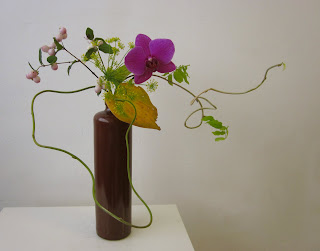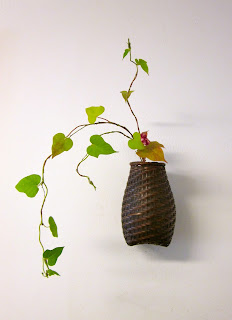Shoka shofutai has its roots in the 18th century. The
3 main lines (Shin, Soe and Tai) are supported by secondary branches or stems
(Ashirai). It expresses the elegance of natural growth. Flowers and leaves are
equally important. Severe regulations dictate the creation of a part of bare
stems before these follow different directions (Mizugiwa). In addition it
honours light and shadow parts of flowers and leaves and it suggests one main
stem from which all the branches seem to depart. Vases are less or more wide
mouthed according to a severe straight-up arrangement (Shin), a broader (Gyo)
or very broad arrangement (So). Many fascinating special teachings exist in
this style. I consider Shoka shofutai the heart of Ikenobo.
08 09 2012: Nishu
ike with Miscanthus and Eustoma
23 06 2012: Ishu ike with peonies
13 02 2012: Ishu ike with tulips: not that easy!
13
02 2012: Ishu ike with Anthurium
20
01 2012: 9 Aspidistra leaves in Matagi
07
01 2012: Ishu ike with Amaryllis
28
10 2011: Ishu ike with Liriope
05 10
2011: Mukogake (matagi) with Morning Glory -first attempt
Flower
gone to Nirvana just before finishing the arrangement
01
10 2011: Futa kabu ike (Autumn workshop)
26
08 2011: Henkagata Tsuki ( first trial)
31
08 2011: Nishu ike with bamboo and Chrysanthemum
06
08 2011: Sanshu ike
October
2010: Nishu ike with Nandina domestica
Demonstration
Japan weekend at Shofukan Centre
July
2010: Iris laevigata
Hosta marks beginning of summer
Shoka
with a Matagi (forked twig or split branch wedged in vase opening) and Tomegi
(piece of stem to close off the space for arrangement) is a traditional
technique and a very special challenge where patience is needed. It also gives
a sense of great contentment.
04 06 2011: Shoka shofutai Ishu ike with
Larkspur( Matagi and Tomegi)
09 03 2013: Shoka shofutai Tomari bune with
tulips
11 05
2013: First exercice of Shoka shofutai Ishu ike Nihomen
( can be viewed
from both front and back)
11 05 2013: Shoka Betsuden (Azalea) - Chudan
nagashi
08 06 2013: Ishu ike with peonies
13 July 2013: Sui Riku ike with Soe-wake
13 July 2013: A pleasant yearly exercise with Hosta
CLICK ON OLDER POSTS FOR REST OF BLOG

























 Autumn 2010
Autumn 2010






































.jpg)















